The 10 Best Low-Maintenance Indoor Plants to Fill Your New Home

Bringing nature into our homes is a design trend we’ve enjoyed for the last few years. Indoor plants may help reduce anxiety and stress, sharpen your attention, boost your productivity, and make any space more inviting. There’s no need to counteract those benefits by stressing about taking care of your plants though!
If you’re a bit nervous about killing yet another houseplant, we’ve put together ten low-maintenance indoor plants that even those with more of a brown thumb than green can enjoy.
1. Snake Plant or Sansevieria

Snake plants are known for their resilience and ability to thrive in various light conditions. It’s a popular and hardy houseplant with stiff, sword-like leaves that can vary in height, ranging from a few inches to several feet. The leaves are usually dark green, with light green or yellow bands running horizontally.
How to care for a snake plant
Snake plants are particularly resilient, with a broad tolerance to growing conditions. They prefer warm, bright light and grow best with adequate daily sunlight. Snake plants are drought-tolerant and like to be slightly dry between waterings. It’s better to underwater these plants than overwater, as they can be prone to root rot if the soil remains excessively wet.
2. ZZ Plant
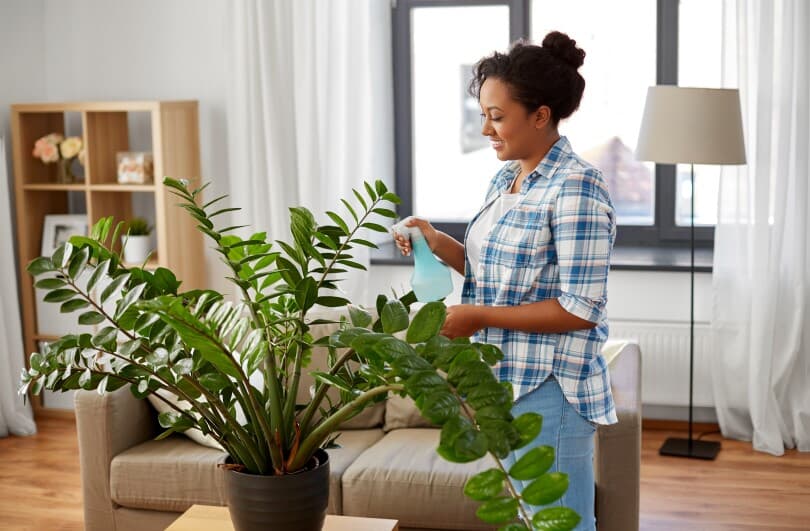
A ZZ plant, also known as Zamioculcas zamiifolia, features thick, waxy leaves that are usually smooth and oval-shaped with a glossy texture. Their leaves can range from dark green to almost black causing the ZZ plant to be often mistaken as artificial.
How to care for a ZZ plant
One of the benefits of the ZZ plant is that it can thrive in many lighting conditions, including low natural light, making them ideal for offices or rooms with few windows. Don’t worry too much if you forget to water this plant – these plants grow from rhizomes (rootstocks), which help them store water under the soil. Allow the soil to dry out between waterings, usually once every two weeks, and thoroughly wet until the water runs out of your pot’s drainage hole. Get rid of any excess water to prevent root rot.
3. Pothos or Devil’s Ivy
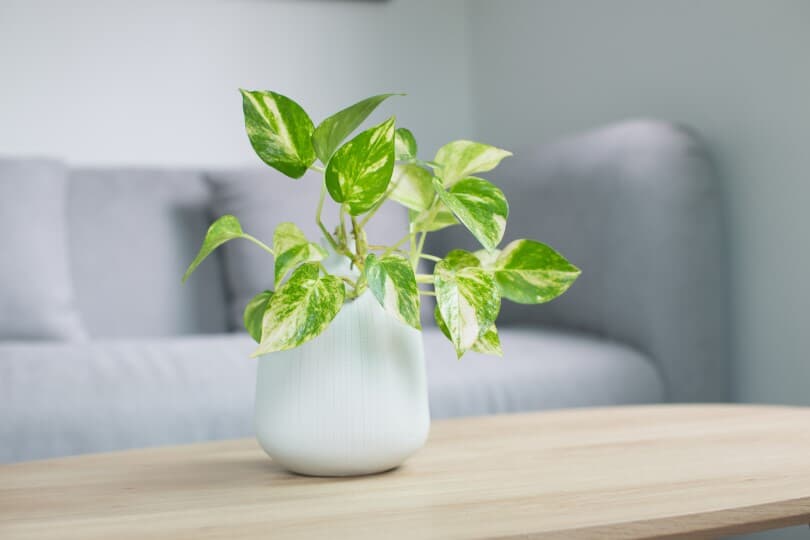
Pothos is a popular trailing vine plant with heart-shaped leaves. The cascading vines can grow quite long if given the opportunity. Pothos leaves come in various shades of green, with some varieties having patches or streaks of yellow or white.
How to care for pothos
Pothos likes sun or shade, but you need to watch if it’s too much of either. They tend to thrive in moderate to bright indirect light but avoid direct sunlight as it can scorch the leaves. Pothos plants prefer slightly moist soil but can tolerate some drying out between waterings. The plant will start to droop when it needs water. Black spots on the leaves indicate that the soil has been kept too wet, while dry brown edges mean the plant was kept too dry for too long.
4. Spider Plant
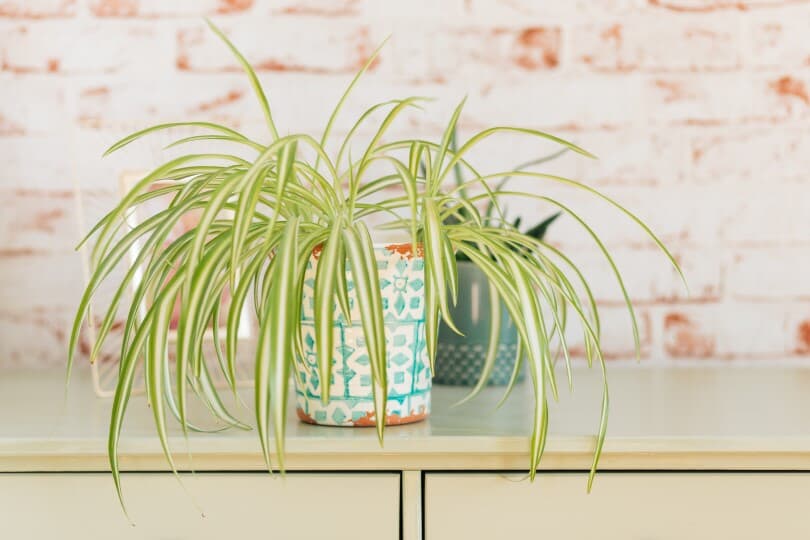
These popular fast-growing plants produce rosettes that grow into arching leaves, also called ribbons, that reach over a foot long. The leaves are typically green, but some varieties have white or cream stripes running along the edges or down the center. Spider plants produce long stems that bear small plantlets or “spiderettes” at their tips. These plantlets eventually develop roots and can be separated to grow new plants.
How to care for a spider plant
Spider plants don’t require much care. They prefer warm, humid rooms and thrive in spots that receive indirect light. For a happy plant, keep the soil slightly moist but never soggy. If your spider plant looks sparse over time, re-pot it so the roots have more room to spread.
5. Peace Lily
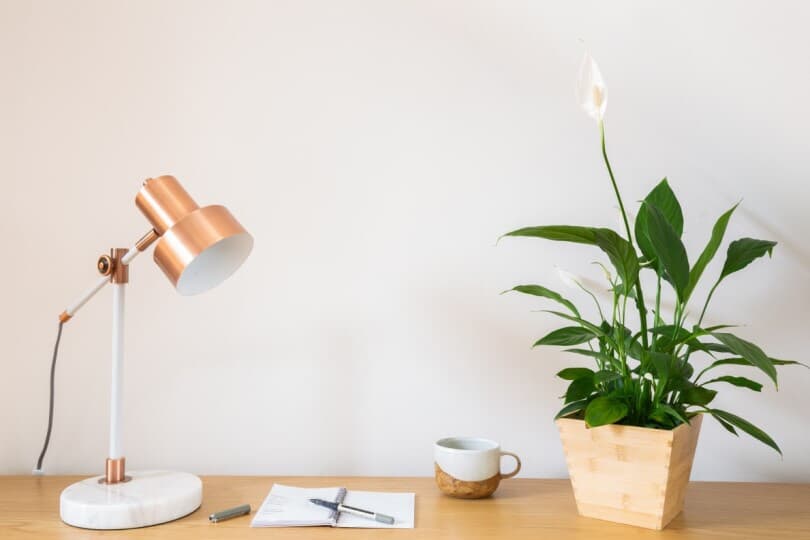
A peace lily is an excellent option if you prefer an indoor flowering plant. These tropical perennials can live for years and repeatedly produce their distinctive white flower. The large glossy green leaves are equally beautiful and calming when the flower is not in bloom.
How to care for a peace lily
Unlike other plants, peace lilies aren’t one you can forget about and have it thrive. Keep the soil lightly moist to the touch but not waterlogged. Peace lilies can tolerate short periods of dry soil, but their leaves will develop brown tips if they don’t have enough water or humidity. Peace lilies are sensitive to chemicals in tap water, so it’s best to use distilled or filtered room-temperature water if possible.
6. Jade Plant
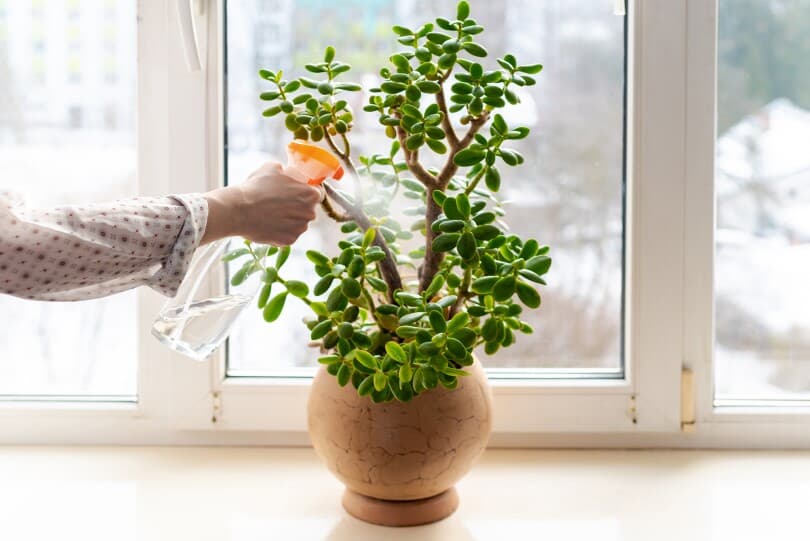
A jade plant, also known as a money plant, is a popular succulent houseplant with thick, oval-shaped leaves that grow opposite each other along sturdy branches. It has simple indoor care requirements and a very long lifespan of up to 70 years with the proper care. The leaves are typically glossy and smooth, with a rich green color. Some varieties may have a reddish tint on the edges or tips of the leaves.
How to care for a jade plant
Jade plants need a lot of light, at least six hours of bright indirect sunlight daily. Place your jade plant near a south or west-facing window to provide sufficient light. Plant in loose, well-draining soil and water it frequently during the spring and summer to keep the soil moist but never soggy. In its native desert climate, this plant is used to receiving deep watering followed by a period of drought. Overwatering introduces more water into the root system than the plant can handle, making it prone to root rot.
7. Tillandsia or Air Plants
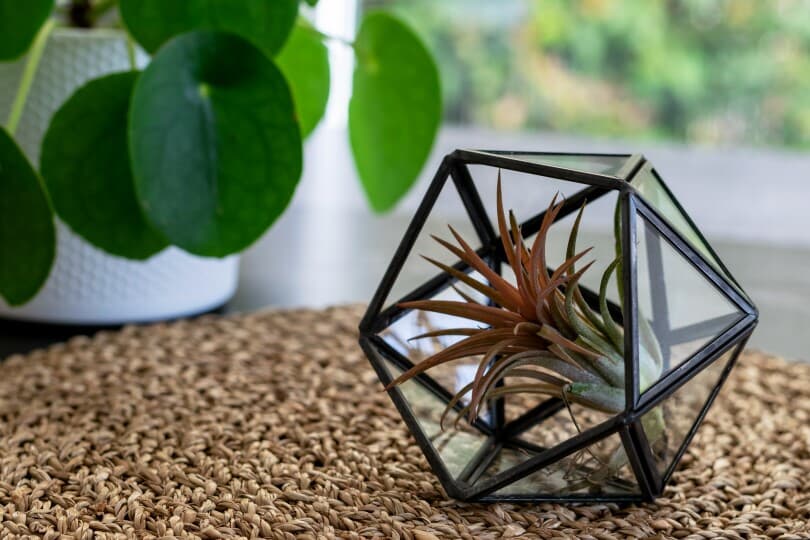
Tillandsia, or air plants, are unique because they don’t require soil to grow. They can be placed in decorative holders or mounted on various surfaces. You can affix air plants to driftwood with fishing line, fill a miniature terrarium, or use any unconventional container you love. They absorb moisture and nutrients from the air, making them incredibly low-maintenance. Air plants come in various shapes, sizes, and colors but typically have a rosette or clump-like form.
How to care for air plants
Air plants thrive in bright indirect light and are more likely to grow flower spikes in these conditions. Unlike traditional plants, air plants absorb water and nutrients through their leaves rather than roots, so they must be watered differently. You can mist them with water using a spray bottle 2-3 times per week or soak them in water for about 20-30 minutes once a week. After soaking or misting, shake off excess water to prevent rot. After watering, make sure the plants dry completely within a few hours. Air plants require good air circulation to avoid moisture buildup and promote healthy growth.
8. Rubber Tree
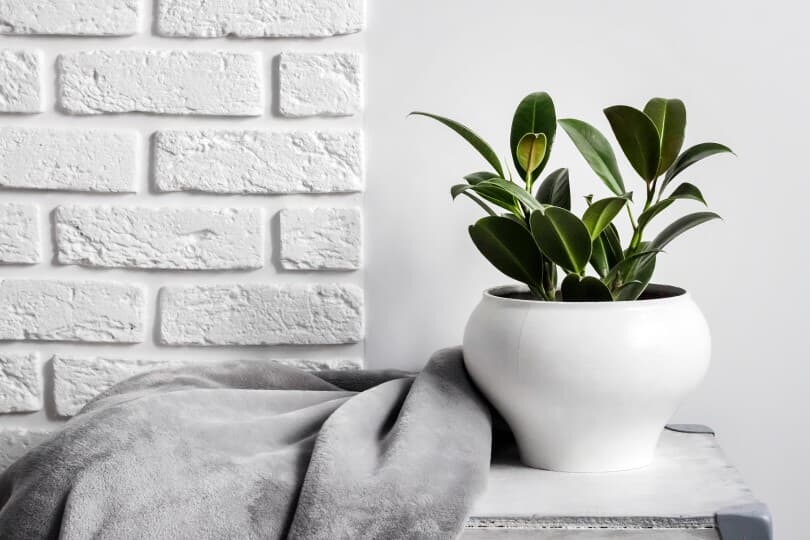
Rubber trees have thick trunks allowing them to grow quite tall, often reaching ceiling height in perfect conditions. The leaves are large, oval-shaped, and waxy-looking. They are typically dark green, but some varieties may have patterns of cream or yellow.
How to care for a rubber tree
When it comes to caring for a rubber tree, it’s pretty straightforward: give it lots of light, moisture, and warmth, and it’ll thrive. Place your rubber tree near a window where it’ll receive soft morning sunlight and away from the harsh direct rays of the afternoon sun. Water your rubber tree frequently so it is steadily moist but not soaked. Rubber trees can adapt to average indoor humidity levels but thrive with slightly higher humidity. You can increase the humidity by misting the leaves or placing a tray of water near the plant.
9. Ponytail Palm
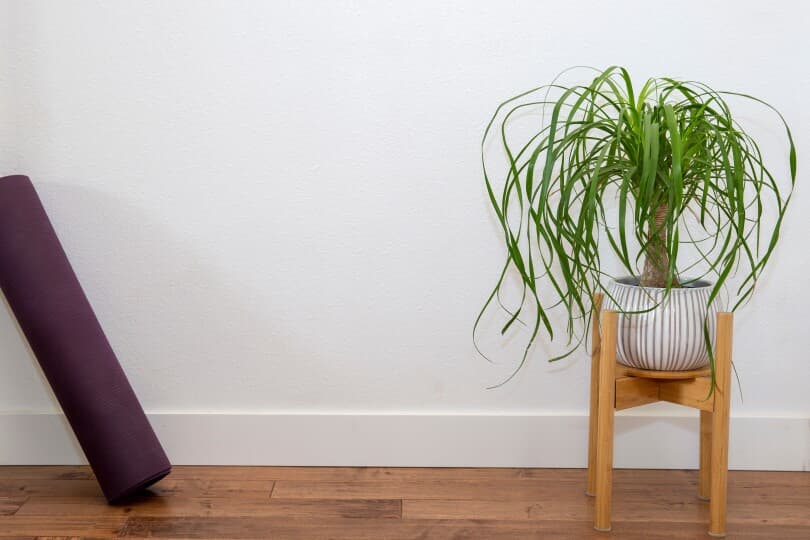
Despite its name and appearance, a ponytail palm is not a true palm but rather a member of the Asparagaceae family that includes edible asparagus. They have a stout, bulbous trunk covered in rough bark that tapers upwards. The leaves are long and arching, resembling a ponytail or cascading fountain. They’re thin, strap-like, have a leathery texture, and range in color from bright green to bluish-green, depending on the variety.
How to care for a ponytail palm
The ponytail palm is basically a “plant it and forget it” type of plant, providing it has enough light to thrive and somewhat steady water throughout the growing season. Place this plant in the brightest location you can find – a window that gets direct sun or plenty of indirect light. Ponytail palms are drought-tolerant plants that store water in their swollen trunks. Allow the soil to dry out between waterings and avoid overwatering.
10. Cast Iron Plant
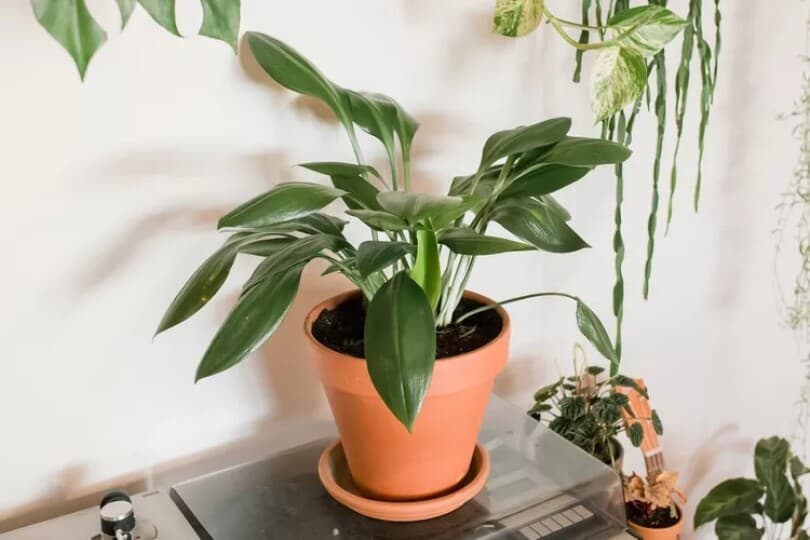
Cast iron plants are perfect if your ideal plant maintenance routine is almost nothing. They are known for their durability and ability to survive neglect, making them ideal for any plant beginner. It’s tough to kill and does a great job of brightening up any room with its deep green, glossy leaves. Cast iron plants have broad, lance-shaped leaves that grow in an upright manner from a central base. They can reach a length of about two feet and have a dense, bushy look.
How to care for a cast iron plant
This plant thrives in areas where all others seem to fail: it needs minimal watering and can survive low light conditions. With cast iron plants, a fairly hands-off approach is typically best, with overwatering being the biggest cause of failure. Water the plant to keep the soil lightly moist but not soggy. Keep cast iron plants away from direct sunlight; a north-facing window is ideal. They can tolerate areas with indirect or filtered light, making them suitable for rooms with little natural light.
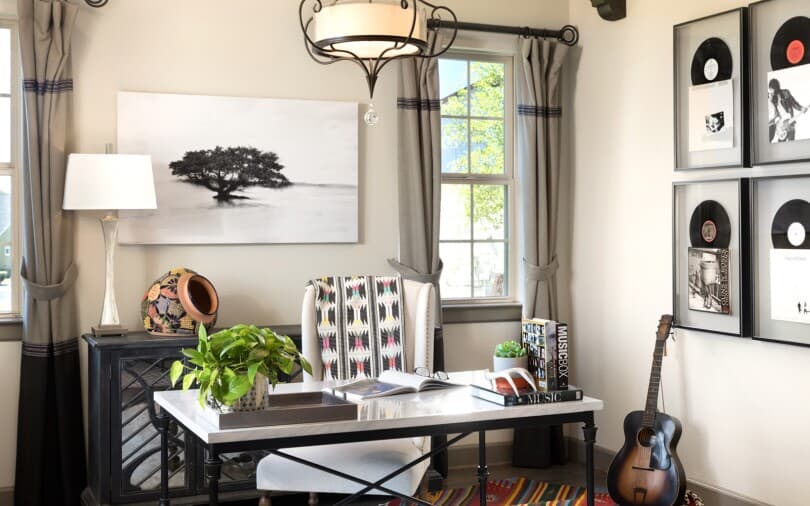
Don’t go out and buy every single “easy” plant, or you’ll defeat the purpose of having easy plants in the first place. Start with a couple of plants that have similar needs, and enjoy the relaxing ambiance they bring to your home!
Check out the Brookfield Residential blog for design advice, homebuying insights, mortgage tips, and more, including Small Space Gardening Ideas and Natural Weed Killer and Pest Control Solutions. You can also explore where we build and connect with our sales team when you’re ready to learn more. We’ll be expecting you!
